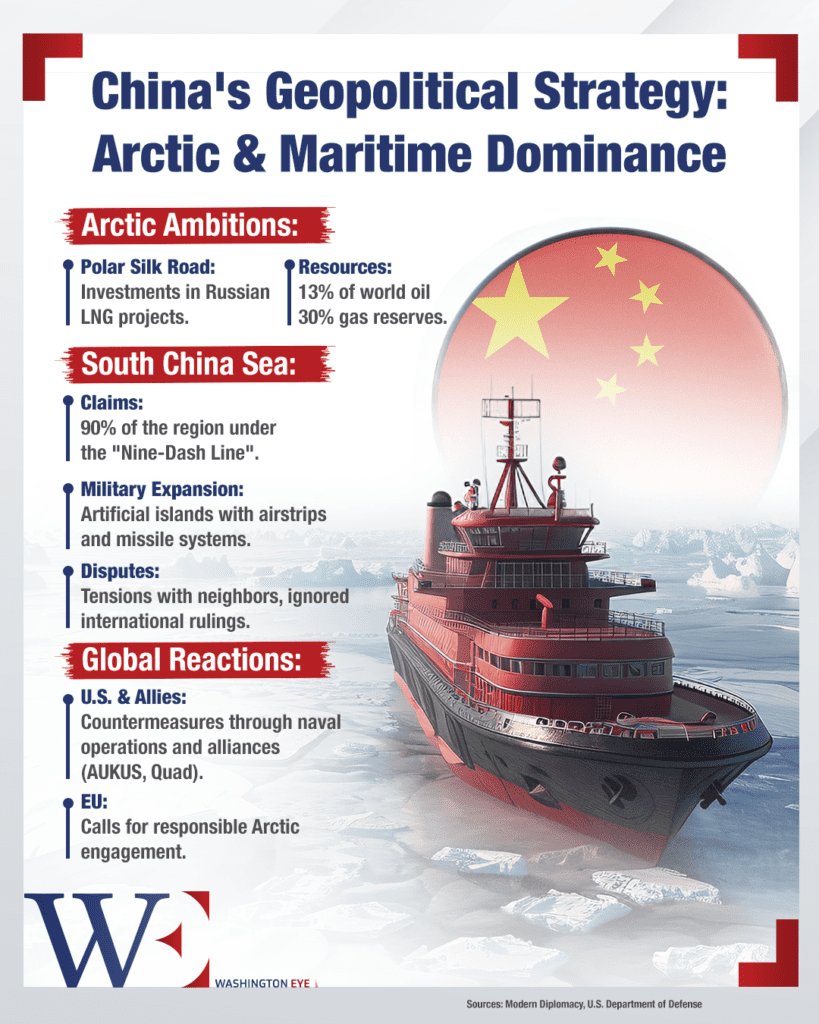As global power dynamics evolve, China is carving out its influence across critical geographies, from the icy waters of the Arctic to the vast expanses of the South China Sea. Its multifaceted approach combines strategic investments, military expansions, and international partnerships to assert dominance and secure its long-term interests. These moves are reshaping global geopolitics and raising concerns among rival nations.
China’s growing involvement in the Arctic region highlights its ambition to extend influence beyond its immediate borders. Despite being a non-Arctic state, Beijing refers to itself as a “near-Arctic nation” in its 2018 White Paper on Arctic Policy. The document outlines plans for scientific research, resource extraction, and the development of a “Polar Silk Road,” an extension of its Belt and Road Initiative (BRI).
The Arctic’s melting ice caps have unveiled new shipping routes and untapped energy reserves. According to the U.S. Geological Survey, the region holds approximately 13% of the world’s undiscovered oil and 30% of its natural gas reserves. This has drawn China’s attention, with investments in Russian Arctic LNG projects and scientific collaborations in the region. “The Arctic holds immense opportunities for sustainable development, and China seeks to work with regional partners to promote peaceful cooperation,” said a spokesperson for China’s Ministry of Foreign Affairs. However, critics argue that China’s intentions go beyond economic collaboration. In 2021, NATO Secretary-General Jens Stoltenberg expressed concerns over China’s strategic ambitions in the Arctic, warning of potential military implications.
Maritime Dominance in the South China Sea
Closer to home, China’s assertive actions in the South China Sea have drawn international scrutiny. This region, rich in fisheries and energy resources, serves as a vital maritime corridor, facilitating one-third of global trade. Beijing claims nearly 90% of the sea under its “Nine-Dash Line,” a demarcation widely disputed by neighboring countries, including the Philippines, Vietnam, and Malaysia. China has fortified its claims by constructing artificial islands equipped with military installations, including airstrips, radar systems, and missile defenses.

A 2022 report by the Asia Maritime Transparency Initiative revealed that China had reclaimed approximately 3,200 acres of land in the Spratly Islands. “Our actions in the South China Sea are legitimate and in line with international law,” stated Chinese Foreign Ministry Spokesperson Wang Wenbin during a press briefing. “China remains committed to resolving disputes through dialogue and cooperation.” Yet, the Permanent Court of Arbitration in The Hague ruled against China’s claims in 2016, a decision Beijing has consistently dismissed. The U.S. and its allies, including Japan and Australia, have conducted Freedom of Navigation Operations (FONOPs) in the region to counter China’s growing influence, further escalating tensions.
Strategic Maritime Partnerships
China’s maritime strategy extends beyond the South China Sea. Through the BRI, Beijing has developed port infrastructure in key locations worldwide, from Gwadar in Pakistan to Hambantota in Sri Lanka. These projects, often labeled as “debt traps” by critics, aim to secure strategic footholds along critical maritime routes. In Africa, China’s investments in Djibouti’s ports and military base signify its intention to protect trade routes and project power in the Indian Ocean. Meanwhile, partnerships in Latin America, including port developments in Panama and Brazil, indicate a growing interest in the Western Hemisphere.
China’s geopolitical moves are deeply intertwined with its economic ambitions. The country’s heavy reliance on maritime trade with over 60% of its oil imports passing through the South China Sea makes securing these routes a strategic necessity. By diversifying its energy sources through Arctic investments and bolstering maritime defenses, China aims to mitigate vulnerabilities and ensure long-term stability. However, these moves have raised alarms globally. The U.S. Department of Defense’s 2023 China Military Power Report highlighted China’s expanding navy, now the world’s largest with over 370 ships. The report predicts the fleet will grow to 440 ships by 2030, emphasizing Beijing’s focus on blue-water capabilities. “China’s growing military presence and strategic investments reflect its ambition to challenge the existing international order,” the report states. “This necessitates a coordinated response from the global community.”
Global powers have responded with mixed strategies. While the U.S. strengthens alliances in the Indo-Pacific through initiatives like AUKUS and the Quadrilateral Security Dialogue (Quad), the European Union has sought to balance engagement with China and protect its Arctic interests. “The Arctic must remain a zone of peace,” said European Commission President Ursula von der Leyen. “We call on China to act transparently and responsibly in its Arctic engagements.” China’s geopolitical strategy from Arctic expansion to maritime dominance illustrates its ambition to reshape global power structures. While these moves offer economic opportunities, they also pose significant challenges to regional stability and international norms. As nations grapple with these shifts, the world watches closely. Will China’s rise lead to new avenues for cooperation or heightened competition? Only time will tell.














